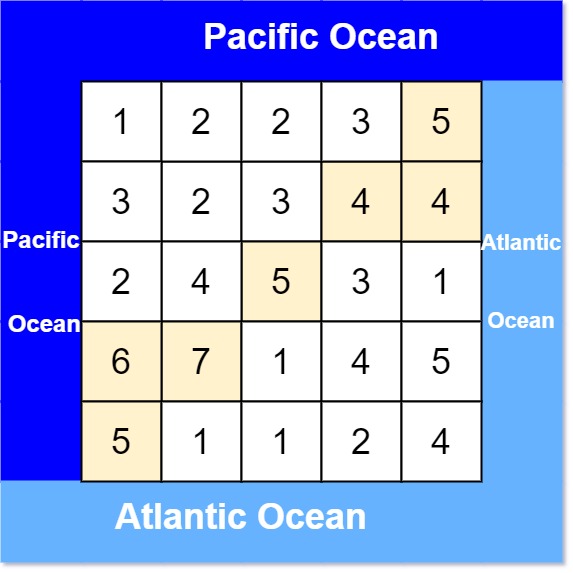- {x}
- Longest Palindrome
- Split Array Largest Sum
- Minimum Unique Word Abbreviation
- Fizz Buzz
- Arithmetic Slices
- Third Maximum Number
- Add Strings
- Partition Equal Subset Sum
- Pacific Atlantic Water Flow
- Sentence Screen Fitting
- Battleships in a Board
- Strong Password Checker
- Maximum XOR of Two Numbers in an Array
- Valid Word Square
- Reconstruct Original Digits from English
- Longest Repeating Character Replacement
- Word Squares
- Read More...

Pacific Atlantic Water Flow
There is an m x n rectangular island that borders both the Pacific Ocean and Atlantic Ocean. The Pacific Ocean touches the island's left and top edges, and the Atlantic Ocean touches the island's right and bottom edges.
The island is partitioned into a grid of square cells. You are given an m x n integer matrix heights where heights[r][c] represents the height above sea level of the cell at coordinate (r, c).
The island receives a lot of rain, and the rain water can flow to neighboring cells directly north, south, east, and west if the neighboring cell's height is less than or equal to the current cell's height. Water can flow from any cell adjacent to an ocean into the ocean.
Return a 2D list of grid coordinates result where result[i] = [ri, ci] denotes that rain water can flow from cell (ri, ci) to both the Pacific and Atlantic oceans.
Example 1:

Input: heights = [[1,2,2,3,5],[3,2,3,4,4],[2,4,5,3,1],[6,7,1,4,5],[5,1,1,2,4]]
Output: [[0,4],[1,3],[1,4],[2,2],[3,0],[3,1],[4,0]]
Explanation: The following cells can flow to the Pacific and Atlantic oceans, as shown below:
[0,4]: [0,4] -> Pacific Ocean
[0,4] -> Atlantic Ocean
[1,3]: [1,3] -> [0,3] -> Pacific Ocean
[1,3] -> [1,4] -> Atlantic Ocean
[1,4]: [1,4] -> [1,3] -> [0,3] -> Pacific Ocean
[1,4] -> Atlantic Ocean
[2,2]: [2,2] -> [1,2] -> [0,2] -> Pacific Ocean
[2,2] -> [2,3] -> [2,4] -> Atlantic Ocean
[3,0]: [3,0] -> Pacific Ocean
[3,0] -> [4,0] -> Atlantic Ocean
[3,1]: [3,1] -> [3,0] -> Pacific Ocean
[3,1] -> [4,1] -> Atlantic Ocean
[4,0]: [4,0] -> Pacific Ocean
[4,0] -> Atlantic Ocean
Note that there are other possible paths for these cells to flow to the Pacific and Atlantic oceans.
Example 2:
Input: heights = [[1]] Output: [[0,0]] Explanation: The water can flow from the only cell to the Pacific and Atlantic oceans.
Constraints:
m == heights.lengthn == heights[r].length1 <= m, n <= 2000 <= heights[r][c] <= 105
Solution Explanation:
This problem asks to find all cells in a matrix that can flow to both the Pacific and Atlantic oceans. Water can flow from a cell to its adjacent cell if the adjacent cell's height is less than or equal to the current cell's height. The Pacific Ocean touches the left and top edges, and the Atlantic Ocean touches the right and bottom edges.
The most efficient approach uses Breadth-First Search (BFS) or Depth-First Search (DFS). We perform two separate searches: one starting from the Pacific Ocean's border and another from the Atlantic Ocean's border.
Algorithm:
-
Initialization:
- Create two sets,
pacificReachableandatlanticReachable, to store cells reachable from the Pacific and Atlantic oceans, respectively. - Create two queues,
pacificQueueandatlanticQueue, for BFS. Initialize them with cells bordering the respective oceans.
- Create two sets,
-
BFS (for Pacific):
- While
pacificQueueis not empty:- Dequeue a cell
(row, col). - For each adjacent cell
(newRow, newCol):- If
(newRow, newCol)is within bounds, not already inpacificReachable, and its height is less than or equal to the current cell's height, add it topacificReachableandpacificQueue.
- If
- Dequeue a cell
- While
-
BFS (for Atlantic): Repeat step 2 for the Atlantic Ocean.
-
Find Common Cells: Iterate through the matrix. If a cell is present in both
pacificReachableandatlanticReachable, add its coordinates to the result list.
Time Complexity: O(M*N), where M and N are the dimensions of the matrix. We visit each cell at most once in each BFS.
Space Complexity: O(M*N) in the worst case, to store the pacificReachable and atlanticReachable sets and the queues.
Code Explanation (Python):
from collections import deque
def pacificAtlantic(heights):
rows, cols = len(heights), len(heights[0])
pacificReachable = set()
atlanticReachable = set()
pacificQueue = deque()
atlanticQueue = deque()
# Add border cells to queues
for r in range(rows):
pacificQueue.append((r, 0)) # Left border
atlanticQueue.append((r, cols - 1)) # Right border
for c in range(cols):
pacificQueue.append((0, c)) # Top border
atlanticQueue.append((rows - 1, c)) # Bottom border
# BFS for Pacific
while pacificQueue:
row, col = pacificQueue.popleft()
pacificReachable.add((row, col))
for dr, dc in [(0, 1), (0, -1), (1, 0), (-1, 0)]:
newRow, newCol = row + dr, col + dc
if (0 <= newRow < rows and 0 <= newCol < cols and
(newRow, newCol) not in pacificReachable and
heights[newRow][newCol] >= heights[row][col]):
pacificQueue.append((newRow, newCol))
# BFS for Atlantic
while atlanticQueue:
row, col = atlanticQueue.popleft()
atlanticReachable.add((row, col))
for dr, dc in [(0, 1), (0, -1), (1, 0), (-1, 0)]:
newRow, newCol = row + dr, col + dc
if (0 <= newRow < rows and 0 <= newCol < cols and
(newRow, newCol) not in atlanticReachable and
heights[newRow][newCol] >= heights[row][col]):
atlanticQueue.append((newRow, newCol))
# Find common cells
result = []
for r in range(rows):
for c in range(cols):
if (r, c) in pacificReachable and (r, c) in atlanticReachable:
result.append([r, c])
return result
The other languages (Java, C++, Go, TypeScript) follow a very similar structure, adapting the data structures and syntax accordingly. The core algorithm remains the same.